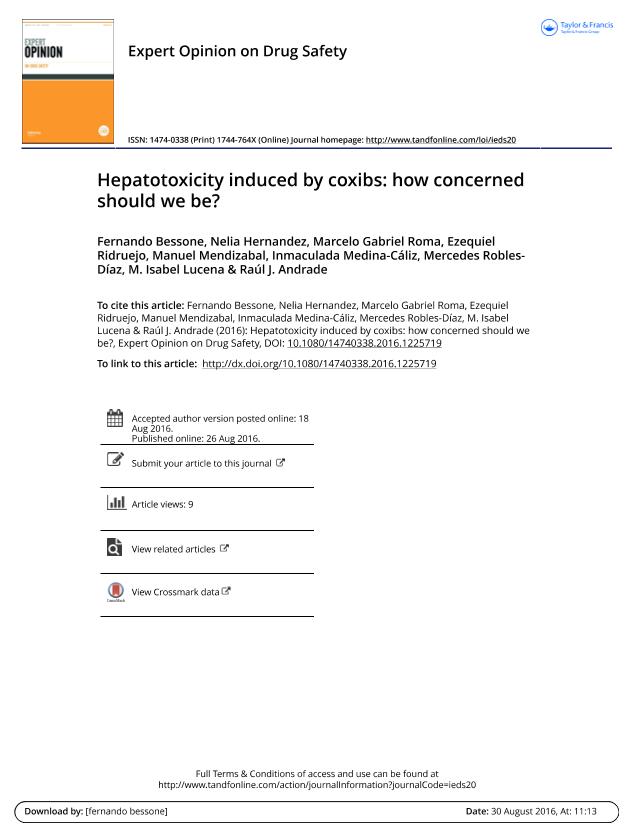Artículo
Hepatotoxicity induced by coxibs: how concerned should we be?
Bessone, Fernando; Hernandez, Nelia; Roma, Marcelo Gabriel ; Ridruejo, Ezequiel
; Ridruejo, Ezequiel ; Mendizabal, Manuel; Medina Cáliz, Inmaculada; Robles Díaz, Mercedes; Lucena, M. Isabel; Andrade, Raúl J.
; Mendizabal, Manuel; Medina Cáliz, Inmaculada; Robles Díaz, Mercedes; Lucena, M. Isabel; Andrade, Raúl J.
 ; Ridruejo, Ezequiel
; Ridruejo, Ezequiel ; Mendizabal, Manuel; Medina Cáliz, Inmaculada; Robles Díaz, Mercedes; Lucena, M. Isabel; Andrade, Raúl J.
; Mendizabal, Manuel; Medina Cáliz, Inmaculada; Robles Díaz, Mercedes; Lucena, M. Isabel; Andrade, Raúl J.
Fecha de publicación:
11/2016
Editorial:
Informa Healthcare
Revista:
Expert Opinion On Drug Safety
ISSN:
1474-0338
Idioma:
Inglés
Tipo de recurso:
Artículo publicado
Clasificación temática:
Resumen
Introduction: The selective inhibitors of COX-2, coxibs, are nonsteroidal anti-inflammatory drugs (NSAIDs) that have much better gastrointestinal safety profile as compared with non-selective NSAIDs. In this review, we analyze both the epidemiological features of coxib-induced hepatotoxicity and the clinical impact of coxib-associated liver damage, based on literature data. Areas covered: We carried out a search of the databases MEDLINE (PubMed), LILACS and SCIELO, from December 1999 to January 2016, to retrieve studies exploring the real impact of coxibs in liver toxicity as compared to non-selective COX-2 inhibitor NSAIDs. Expert opinion: Although reliable data on the incidence of celecoxib- and etoricoxib-induced hepatotoxicity are lacking, because of cohort studies have been generally underpowered to detect hepatic events, coxibs have been scarcely related to hepatotoxicity. Hence, coxib-induced liver injury seems to be an uncommon event, yet exhibits a wide spectrum of damage. Increasing COX-2 drug selectivity, as for rofecoxib, valdecoxib, parecoxib, and lumiracoxib, has been associated with higher cardiovascular risk, as well as dermatological and serious hepatic reactions. The actual risk of liver toxicity from the currently approved coxibs compared with non-selective NSAIDs will be discussed. Finally, classical and novel molecular mechanisms of coxib-induced hepatotoxicity are also described.
Archivos asociados
Licencia
Identificadores
Colecciones
Articulos(IFISE)
Articulos de INST.DE FISIOLOGIA EXPERIMENTAL (I)
Articulos de INST.DE FISIOLOGIA EXPERIMENTAL (I)
Citación
Bessone, Fernando; Hernandez, Nelia; Roma, Marcelo Gabriel; Ridruejo, Ezequiel; Mendizabal, Manuel; et al.; Hepatotoxicity induced by coxibs: how concerned should we be?; Informa Healthcare; Expert Opinion On Drug Safety; 15; 11; 11-2016; 1463-1475
Compartir
Altmétricas



